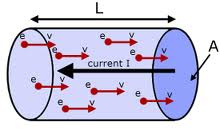
The drift velocity is the average velocity that a particle, such as an electron, attains in a material due to an electric field. It can also be referred to as axial drift velocity. In general, an electron will propagate randomly in a conductor at the Fermi velocity.
When a conductor is subjected to an electric field E, each electron experiences a force
F = - eE, and free electron acquires an
acceleration, a= F/m = - eE/m ... (i)
where, m = mass of electron, e = electronic charge and E = electric field.
Free electron starts accelerating and gains velocity and collide with atoms and molecules of the conductor. The average time difference between two consecutive collisions is known as relaxation time of electron and
{tex}\overline { \tau } = \frac { \tau _ { 1 } + \tau _ { 2 } + \ldots + \tau _ { n } } { n }{/tex} ...(ii)
where, {tex}\tau_{1}, \; \tau_{2}.... \; \tau_{n}{/tex} are the average time difference between 1st, 2nd, ...nth collisions.
{tex}\therefore{/tex} v1, v2, ... vn, are velocities gained by electron in 1st, 2nd, ..., nth collisions with initial thermal velocities u1, u2, ..., un, respectively.
{tex}\therefore \quad { v } _ { 1 } = { u } _ { 1 } + { a } \tau _ { 1 }{/tex}
Similarly,
{tex}\mathop {{v_2}}\limits_ \vdots = \mathop {{u_2}}\limits_ \vdots + \mathop {a{\tau _2}}\limits_ \vdots {/tex}
{tex}{v_n} = {u_n} + a{\tau _2}{/tex}
The drift speed vd may be defined as
{tex}v _ { d } = \frac { v _ { 1 } + v _ { 2 } + \ldots + v _ { n } } { n }{/tex}
{tex}v _ { d } = \frac { \left( u _ { 1 } + u _ { 2 } + \ldots + u _ { n } \right) + a \left( \tau _ { 1 } + \tau _ { 2 } + \ldots + \tau _ { n } \right) } { n }{/tex}
{tex} { v } _ { d } = \frac { \left( { u } _ { 1 } + { u } _ { 2 } + \ldots + { u } _ { n } \right) } { n } + \frac { { a } \left( \tau _ { 1 } + \tau _ { 2 } + \ldots + \tau _ { n } \right) } { n }{/tex}
{tex}v _ { d } = 0 + { a } \tau{/tex} [{tex}\because{/tex} Average thermal velocity in n collisions = 0]
{tex}{ v } _ { d } = - ( e { E } / m ) \tau{/tex} [from Eq. (i)]
This is the required expression of drift speed of free electrons in a conductor in a presence of voltage source.




 myCBSEguide
myCBSEguide

Sia ? 4 years, 9 months ago
The drift velocity is the average velocity that a particle, such as an electron, attains in a material due to an electric field. It can also be referred to as axial drift velocity. In general, an electron will propagate randomly in a conductor at the Fermi velocity.
When a conductor is subjected to an electric field E, each electron experiences a force
F = - eE, and free electron acquires an
acceleration, a= F/m = - eE/m ... (i)
where, m = mass of electron, e = electronic charge and E = electric field.
Free electron starts accelerating and gains velocity and collide with atoms and molecules of the conductor. The average time difference between two consecutive collisions is known as relaxation time of electron and
{tex}\overline { \tau } = \frac { \tau _ { 1 } + \tau _ { 2 } + \ldots + \tau _ { n } } { n }{/tex} ...(ii)
where, {tex}\tau_{1}, \; \tau_{2}.... \; \tau_{n}{/tex} are the average time difference between 1st, 2nd, ...nth collisions.
{tex}\therefore{/tex} v1, v2, ... vn, are velocities gained by electron in 1st, 2nd, ..., nth collisions with initial thermal velocities u1, u2, ..., un, respectively.
{tex}\therefore \quad { v } _ { 1 } = { u } _ { 1 } + { a } \tau _ { 1 }{/tex}
Similarly,
{tex}\mathop {{v_2}}\limits_ \vdots = \mathop {{u_2}}\limits_ \vdots + \mathop {a{\tau _2}}\limits_ \vdots {/tex}
{tex}{v_n} = {u_n} + a{\tau _2}{/tex}
The drift speed vd may be defined as
{tex}v _ { d } = \frac { v _ { 1 } + v _ { 2 } + \ldots + v _ { n } } { n }{/tex}
{tex}v _ { d } = \frac { \left( u _ { 1 } + u _ { 2 } + \ldots + u _ { n } \right) + a \left( \tau _ { 1 } + \tau _ { 2 } + \ldots + \tau _ { n } \right) } { n }{/tex}
{tex} { v } _ { d } = \frac { \left( { u } _ { 1 } + { u } _ { 2 } + \ldots + { u } _ { n } \right) } { n } + \frac { { a } \left( \tau _ { 1 } + \tau _ { 2 } + \ldots + \tau _ { n } \right) } { n }{/tex}
{tex}v _ { d } = 0 + { a } \tau{/tex} [{tex}\because{/tex} Average thermal velocity in n collisions = 0]
{tex}{ v } _ { d } = - ( e { E } / m ) \tau{/tex} [from Eq. (i)]
This is the required expression of drift speed of free electrons in a conductor in a presence of voltage source.
2Thank You